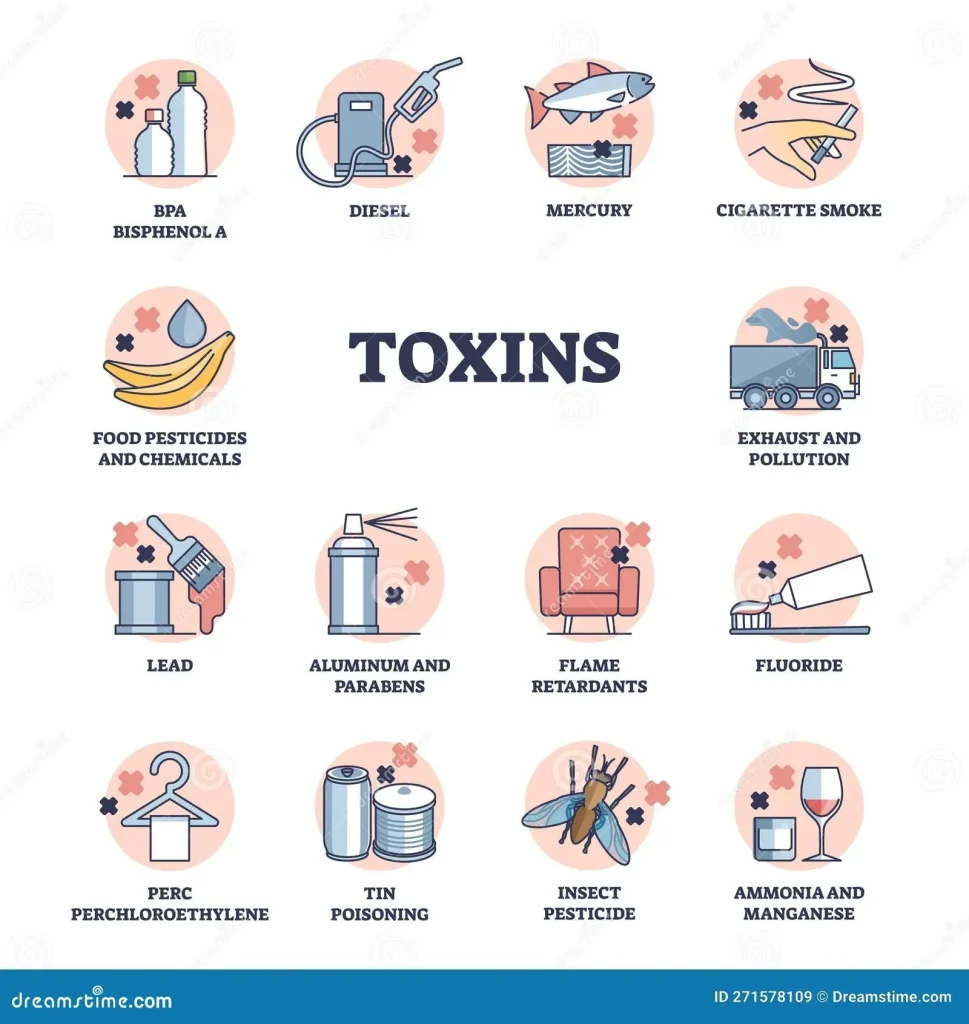Toxins are a vital part of our understanding of health and safety, but there’s often confusion about what exactly they are. In simple terms, toxins are harmful substances that can be produced by living organisms, and their health effects can vary dramatically depending on the dose and individual sensitivity. Understanding toxins explained involves knowing that both natural poisons and man-made toxic substances can pose risks to our well-being. The scary reality is that exposure to toxins is more common than you might think, occurring in many everyday products and environments. As we delve deeper into what are toxins, it’s essential to consider how these toxic agents are measured and the potential health implications of long-term exposure.
When discussing toxic agents, the conversation often revolves around harmful substances that impact human health. These hazardous chemicals, whether originating from nature or synthesized in laboratories, can lead to significant health ramifications if not properly managed. It’s crucial to recognize that not every encounter with these substances will result in harm, as the effects largely depend on exposure levels. By understanding the broader implications of toxicants, we can better equip ourselves to navigate the often misrepresented narratives surrounding them. In light of this, a thorough examination of the health effects of toxins and the methods for measuring them becomes increasingly important.
Understanding Toxins: Definition and Classification
Toxins are defined as harmful substances produced by living organisms, such as plants, animals, bacteria, and viruses. Examples include snake venom and certain varieties of mushrooms that can be lethal if ingested. This understanding of toxins emphasizes their biological origin and the complex interaction they have in ecosystems, often serving defensive roles for the organisms that produce them. Toxicologists clarify that not all toxins are created equal; while some are acutely dangerous in small amounts, others may require larger quantities to pose any risk to human health.
In contrast, the term ‘toxicant’ is reserved for manmade chemicals, including synthetic substances often found in industrial products and consumer goods. Despite the distinctions, the general public frequently uses ‘toxin’ to describe both classes of substances. This broad application can sometimes lead to misunderstandings when discussing health-related topics. For example, understanding the different natures of these substances is essential for assessing their potential dangers and health implications.
How Toxins are Measured: Understanding Toxicity Levels
Measuring the toxicity of substances involves scientific methodologies, with one common measure being the LD50 value. LD50, or the lethal dose for 50% of a population, provides a benchmark for understanding how much of a toxic substance can lead to mortality. This measurement, however, primarily relies on animal studies, leaving gaps in human toxicity data. For instance, while fentanyl can be prescribed safely at therapeutic doses, its deadly potential in overdose scenarios underscores the complexities involved in determining safe exposure levels for humans.
Moreover, long-term exposure to low levels of toxins poses a significant risk that is often overlooked. Chemicals like PFAS, commonly referred to as ‘forever chemicals,’ accumulate in the body over time and can lead to serious health consequences. Toxins can build up insidiously, making chronic exposure especially dangerous. Health professionals emphasize the importance of tests to measure the presence of these harmful substances in the body, which can often reveal accumulated levels of toxins that might not show immediate symptoms but can still have a profound impact on long-term health.
The Health Effects of Toxins: Individual Risks and Vulnerabilities
Exposure to toxins doesn’t always result in immediate health issues. The effects of these harmful substances can vary widely based on individual factors, including genetics, age, overall health, and even nutrition. For instance, children and pregnant women are generally more susceptible to toxins, as their bodies are still developing and more vulnerable to the potential harm posed by exposure to toxic substances. Understanding the nuanced interactions between toxins and human health underscores the significance of a more personalized approach to health care.
Despite the potential risks, the human body has developed sophisticated detoxification mechanisms to handle certain levels of exposure. Organs such as the liver and kidneys play crucial roles in breaking down and eliminating toxins. Healthy individuals often can metabolize moderate amounts of harmful substances without serious health repercussions. However, when the body’s detoxification processes are overwhelmed—either due to high levels of exposure or pre-existing health conditions—problems can arise, highlighting the importance of monitoring environmental and dietary exposures.
Misconceptions about Toxins: Navigating Misinformation
The term ‘toxic’ is often misused on social media, leading to confusion and fear among the public. Influencers and alternative health advocates may label common foods or ingredients, such as seed oils or kale, as ‘toxic’ without substantial scientific backing. This sensationalist approach can obscure the genuine threats posed by actual toxins and toxicants, making it challenging for people to navigate real health risks versus exaggerated claims.
Toxicologists urge caution when interpreting claims about toxins found online, as misinformation can lead to unnecessary panic and fear-based reactions. The complexity of toxins’ effects on human health cannot be overstated; they require informed discussions that consider dosage, exposure methods, and individual susceptibility. Therefore, consulting healthcare professionals and relying on scientific evidence is crucial for accurate information regarding toxic substances and their health impacts.
When to Seek Help: Recognizing Toxic Exposure Symptoms
Recognizing the symptoms of potential poisoning is crucial for timely medical intervention. Common signs of toxic exposure include headache, nausea, dizziness, and difficulty breathing. Those aware of their exposure to a potentially hazardous substance should seek emergency medical care immediately. Being proactive in addressing these symptoms can often be the difference between a favorable outcome and serious health complications related to toxic exposure.
Moreover, individuals concerned about long-term exposure to toxins from everyday products should initiate discussions with their healthcare providers. Doctors can conduct specialized tests to measure toxin levels in blood or urine, providing essential insights into one’s health status relative to toxic substances. This proactive approach helps individuals understand their specific risks and can guide them in making more informed lifestyle choices.
Preventing Toxin Exposure: Practical Tips
To decrease the risk of toxin exposure, individuals can adopt practical strategies such as minimizing the use of plastic containers, opting for natural cleaning products, and avoiding processed foods laden with synthetic chemicals. Awareness of the potential sources of toxins in everyday products can empower people to make healthier choices that mitigate their exposure. For example, understanding which substances to limit or eliminate from personal care and household goods significantly reduces cumulative toxin intake.
Additionally, educating oneself about the ingredients in food and personal products plays a critical role in toxin prevention. Reading labels, staying informed about the latest research on food safety, and being conscious of environmental toxins in the community are vital steps in minimizing exposure to harmful substances. Engaging in this proactive health management fosters a greater community awareness of the risks associated with toxins and helps cultivate a healthier environment for everyone.
Natural Detoxification: How the Body Protects Itself
The human body possesses remarkable detoxification systems that work tirelessly to protect against harmful substances. Key organs, such as the liver and kidneys, play vital roles in breaking down and eliminating toxins from the body. These organs filter the blood and process various substances, transforming potential threats into less harmful compounds that can be excreted safely. Understanding this intrinsic detoxification process highlights how resilient the human body can be in handling everyday exposures.
However, reliance solely on these natural detoxification systems is not sufficient for everyone, particularly individuals with compromised health or those exposed to high levels of toxins. While the body can manage moderate exposures effectively, chronic exposure to significant toxins can strain its detoxification capabilities. Therefore, understanding the body’s limits emphasizes the relevance of reducing toxic exposure through lifestyle choices, further supporting health maintenance.
Environmental Toxins: Effects on Public Health
As society becomes more industrialized, the presence of environmental toxins has increased, raising critical public health concerns. Chemicals such as heavy metals, pesticides, and industrial solvents not only pollute the environment but can also seep into our homes and food supply. Long-term exposure to these substances has been linked to various chronic health issues, making it essential for communities to advocate for cleaner environments and stricter regulations regarding toxic substances.
Addressing environmental toxins requires collective action, including policy changes and public awareness campaigns that educate populations about the dangers of pollution. Communities can push for better healthcare initiatives that monitor and manage the health effects associated with toxic exposure, fostering safer living and working environments. Such measures not only protect individual health but also promote public health on a broader scale.
The Science of Detoxification: What You Need to Know
Detoxification is not just a trending health buzzword; it is a scientifically recognized process the body undergoes to eliminate harmful substances. While some diets and detox regimens claim to expedite this body’s natural detox processes, it’s essential to acknowledge that the liver, kidneys, and digestive system already perform this function efficiently in most healthy individuals. Understanding the biological basis of detoxification can help dispel myths surrounding detox diets that lack scientific support.
Moreover, recognizing that many detox solutions can focus on unproven claims promotes a more informed dialogue about what detoxification truly involves. The reality is that substantial exposure to certain environmental toxins may require different approaches compared to maintaining day-to-day health. Future research will continue to elucidate the complexities of toxicity and the body’s capabilities, offering insights into improving public health strategies related to detoxification.
Frequently Asked Questions
What are toxins and how are they defined?
Toxins are chemicals produced by living organisms, such as plants, animals, bacteria, or viruses, that can be poisonous. For example, snake venom or mushroom toxins are classified as natural toxins. Toxins can also refer to synthetic substances, often called toxicants, which may harm health.
How can we measure toxins to assess their health effects?
Toxins can be measured using various methods, such as the LD50, which indicates the lethal dose for 50% of a population. Understanding the dose is crucial, as anything can be toxic at high levels. Long-term exposure to low doses of toxins can also be assessed through blood or urine tests to determine health impacts.
Are the health effects of toxins always harmful?
Not all exposure to toxins is harmful. Individual responses to toxins vary based on factors like age, genetics, and overall health. While some people may experience adverse effects from low doses, healthy individuals often manage exposure effectively through natural detoxification processes.
How do toxic substances affect long-term health?
Long-term exposure to toxic substances, such as PFAS or lead, can accumulate in the body and potentially lead to health issues over time. Ongoing research aims to better understand these health impacts, emphasizing the importance of monitoring exposure levels.
What precautions should I take regarding exposure to toxins?
If you suspect exposure to a toxic substance, monitor for symptoms like headaches, dizziness, or nausea, and consult a healthcare professional. For concerns about long-term exposure, discuss testing options with your doctor to assess potential health risks from toxins.
What should I consider when encountering claims about toxins on social media?
Be cautious of information about toxins shared on social media, as it can be misleading or oversimplified. It’s essential to research claims about toxic substances critically and consult healthcare professionals for accurate information to avoid fear-based misinformation.
What distinguishes a toxin from a toxicant?
While toxins are generally defined as natural poisons produced by living organisms, toxicants are man-made substances that can also be harmful. Both terms are often used interchangeably in casual conversations but have distinct definitions in toxicology.
| Key Points | Details |
|---|---|
| Definition of Toxin | A chemical produced by a living organism that is poisonous, such as snake venom or certain mushrooms. |
| Toxicant | Manmade substances that may be poisonous, such as forever chemicals or synthetics. |
| LD50 Measurement | The median lethal dose for 50% of a population, indicating how much of a substance can be dangerous. |
| Long-term Exposure Risks | Extended low-level exposure to certain toxins can lead to health risks, such as lead or PFAS. |
| Individual Variability | Different individuals react differently to toxins based on age, weight, genetics, and health status. |
| Signs of Toxic Exposure | Symptoms may include headache, dizziness, weakness, nausea, etc. Seek emergency care if experiencing severe symptoms. |
| Misinformation Concern | Social media often spreads misleading claims about what is toxic. Always verify and consult with a medical professional. |
Summary
Toxins are substances that can pose a serious threat to health, but understanding them requires nuance and careful consideration. While social media often sensationalizes claims about various foods and products being toxic, experts emphasize that toxicity is highly dependent on the dose and individual exposure. It’s essential for individuals to recognize that not all toxins will necessarily harm everyone; responses vary based on a person’s health and circumstances. Therefore, informed discussions and consultations with healthcare professionals can provide clarity in a landscape rife with misinformation about toxins.



